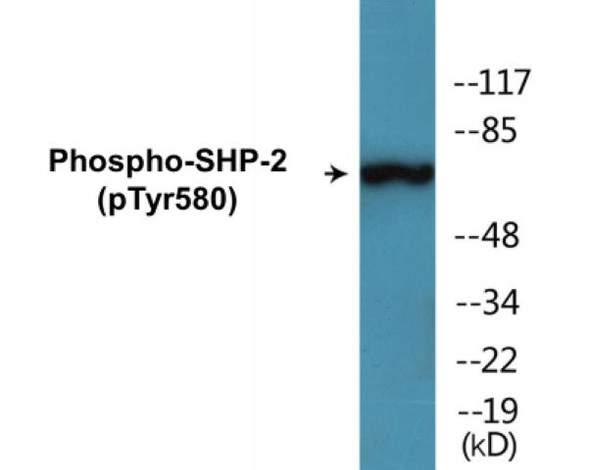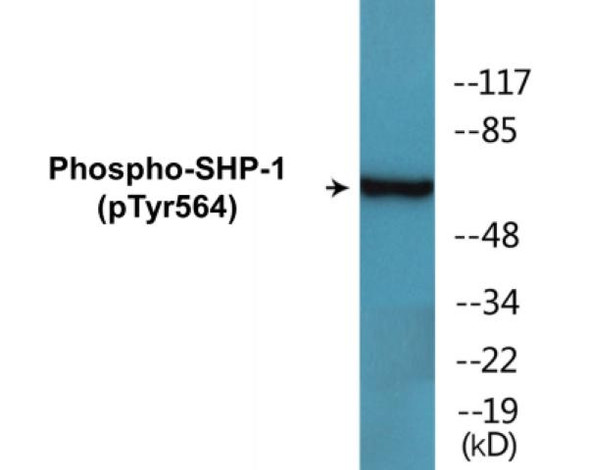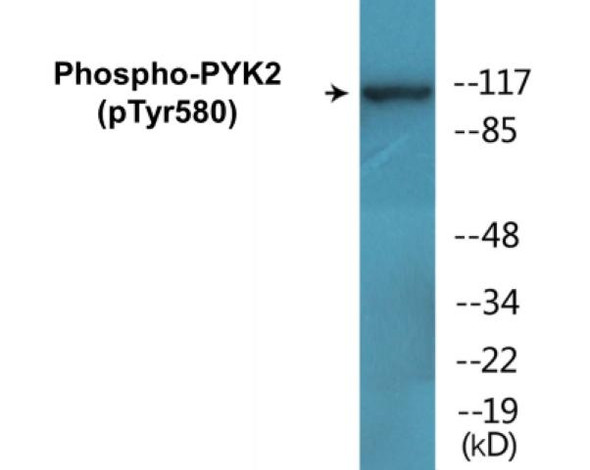Description
SHP-2 (Phospho-Tyr580) Cell-Based ELISA Kit
The SHP-2 (Phospho-Tyr580) Cell-Based ELISA Kit is a convenient, lysate- free, high throughput and sensitive assay kit that can monitor SHP-2 phosphorylation and expression profile in cells. The kit can be used for measuring the relative amounts of phosphorylated SHP-2 in cultured cells as well as screening for the effects that various treatments, inhibitors (ie. siRNA or chemicals), or activators have on SHP-2 phosphorylation.
How does our SHP-2 (Phospho-Tyr580) Fluorometric Cell-Based ELISA Kit work?
Qualitative determination of SHP-2 (Phospho-Tyr580) concentration is achieved by an indirect ELISA format. In essence, SHP-2 (Phospho-Tyr580) is captured by SHP-2 (Phospho-Tyr580)-specific primary (1°) antibodies while Dye 1-conjugated and Dye 2-conjugated secondary (2°) antibodies bind the Fc region of the 1° antibody. Through this binding, the dye conjugated to the 2° antibody can emit light at a certain wavelength given proper excitation, hence allowing for a fluorometric detection method. Due to the qualitative nature of the Cell-Based ELISA, multiple normalization methods are needed:
| 1. | A monoclonal antibody specific for human GAPDH is included to serve as an internal positive control in normalizing the target RFU values. |
| 2. | An antibody against the nonphosphorylated counterpart of SHP-2 (Phospho-Tyr580) is also provided for normalization purposes. The RFU values obtained for non-phosphorylated SHP-2 can be used to normalize the RFU value for phosphorylated SHP-2. |
SHP-2 (Phospho-Tyr580) Fluorometric Cell-Based ELISA Kit -Information
| Product Name: | SHP-2 (Phospho-Tyr580)Fluorometric Cell-Based ELISA Kit |
| Product Code/SKU: | FBCAB00005 |
| Description: | The SHP-2 (Phospho-Tyr580) Fluorometric Cell-Based Phospho ELISA Kit is a convenient, lysate-free, high throughput and sensitive assay kit that can monitor SHP-2 (Phospho-Tyr580) protein phosphorylation and expression profile in cells. The kit can be used for measuring the relative amounts of phosphorylated SHP-2 (Phospho-Tyr580) in cultured cells as well as screening for the effects that various treatments, inhibitors (ie. siRNA or chemicals, or activators have on PTPN11 phosphorylation. |
| Dynamic Range: | > 5000 Cells |
| Detection Method: | Fluorometric |
| Storage/Stability: | 4°C/6 Months |
| Reactivity: | Human, Mouse, Rat |
| Assay Type: | Cell-Based ELISA |
| Database Links: | Gene ID: 5781, UniProt ID: Q06124, OMIM #: 151100/163950/163955/176876/607785, Unigene #: Hs.506852/Hs.646231 |
| Format: | Two 96-Well Plates |
| NCBI Gene Symbol: | PTPN11 |
| Sub Type: | Phospho |
| Target Name: | Phospho-SHP-2 (Tyr580) |
Kit Principle
Figure: Schematic representation of Assay Genie Cell-Based Fluorometric ELISA principle
Kit components | Quantity |
| 96-Well Black Cell CultureClear-Bottom Microplate | 2 plates |
| 10X TBS | 24 ml |
| Quenching Buffer | 24 ml |
| Blocking Buffer | 50 ml |
| 15X Wash Buffer | 50 ml |
| Primary Antibody Diluent | 12 ml |
| 100x Anti-Phospho Target Antibody | 60 µl |
| 100x Anti-Target Antibody | 60 µl |
| Anti-GAPDH Antibody | 110 µl |
| Dye-1 Conjugated Anti-Rabbit IgG Antibody | 6 ml |
| Dye-2 Conjugated Anti-Mouse IgG Antibody | 6 ml |
| Adhesive Plate Seals | 2 seals |
Additional equipment and materials required
The following materials and/or equipment are NOT provided in this kit but are necessary to successfully conduct the experiment:
- Fluorescent plate reader with two channels at Ex/Em: 651/667 and 495/521
- Micropipettes capable of measuring volumes from 1 µl to 1 ml
- Deionized or sterile water (ddH2O)
- 37% formaldehyde (Sigma Cat# F-8775) or formaldehyde from other sources
- Squirt bottle, manifold dispenser, multichannel pipette reservoir or automated microplate washer
- Graph paper or computer software capable of generating or displaying logarithmic functions
- Absorbent papers or vacuum aspirator
- Test tubes or microfuge tubes capable of storing ≥1 ml
- Poly-L-Lysine (Sigma Cat# P4832 for suspension cells)
- Orbital shaker (optional)
Kit Protocol
This is a summarized version of the kit protocol. Please view the technical manual of this kit for information on sample preparation, reagent preparation and plate lay out.
| 1. | Seed 200 µl of desired cell concentration in culture medium into each well of the 96-well plates. For suspension cells and loosely attached cells, coat the plates with 100 µl of 10 µg/ml Poly-L-Lysine (not included) to each well of a 96-well plate for 30 minutes at 37°C prior to adding cells. |
| 2. | Incubate the cells for overnight at 37°C, 5% CO2. |
| 3. | Treat the cells as desired. |
| 4. | Remove the cell culture medium and rinse with 200 µl of 1x TBS, twice. |
| 5. | Fix the cells by incubating with 100 µl of Fixing Solution for 20 minutes at room temperature. The 4% formaldehyde is used for adherent cells and 8% formaldehyde is used for suspension cells and loosely attached cells. |
| 6. | Remove the Fixing Solution and wash the plate 3 times with 200 µl 1x Wash Buffer for 3 minutes. The plate can be stored at 4°C for a week. |
| 7. | Add 100 µl of Quenching Buffer and incubate for 20 minutes at room temperature. |
| 8. | Wash the plate 3 times with 1x Wash Buffer for 3 minutes each time. |
| 9. | Dispense 200 µl of Blocking Buffer and incubate for 1 hour at room temperature. |
| 10. | Wash 3 times with 200 µl of 1x Wash Buffer for 3 minutes each time. |
| 11. | Add 50 µl of Primary Antibody Mixture P to corresponding wells for SHP-2 (Phospho-Tyr580) detection. Add 50 µl of Primary Antibody Mixture NP to the corresponding wells for total SHP-2 detection. Cover the plate with parafilm and incubate for 16 hours (overnight) at 4°C. If the target expression is known to be high, incubate for 2 hours at room temperature. |
| 12. | Wash 3 times with 200 µl of 1x Wash Buffer for 3 minutes each time. |
| 13. | Add 50 ul of Secondary Antibody Mixture to corresponding wells and incubate for 1.5 hours at room temperature in the dark. |
| 14. | Wash 3 times with 200 µl of 1x Wash Buffer for 3 minutes each time. |
| 15. | Read the plate(s) at Ex/Em: 651/667 (Dye 1) and 495/521 (Dye 2). Shield plates from direct light exposure. |
| 16. | Wash 3 times with 200 µl of 1x Wash Buffer for 5 minutes each time. |
SHP-2 (Phospho-Tyr580) - Protein Information
| UniProt Protein Function: | SHP-2: a SH2-containing a ubiquitously expressed tyrosine-specific protein phosphatase. It participates in signaling events downstream of receptors for growth factors, cytokines, hormones, antigens and extracellular matrices in the control of cell growth, differentiation, migration, and death. Activation of SHP-2 and its association with Gab1 is critical for sustained Erk activation downstream of several growth factor receptors and cytokines. |
| UniProt Protein Details: | Protein type:Motility/polarity/chemotaxis; Protein phosphatase, tyrosine (non-receptor); EC 3.1.3.48 Chromosomal Location of Human Ortholog: 12q24 Cellular Component: cytoplasm; cytosol; nucleus Molecular Function:1-phosphatidylinositol-3-kinase activity; insulin receptor binding; non-membrane spanning protein tyrosine phosphatase activity; phosphatidylinositol-4,5-bisphosphate 3-kinase activity; phosphoprotein phosphatase activity; protein binding; protein tyrosine phosphatase activity; SH3/SH2 adaptor activity Biological Process: brain development; ephrin receptor signaling pathway; epidermal growth factor receptor signaling pathway; fibroblast growth factor receptor signaling pathway; genitalia development; heart development; inner ear development; leukocyte migration; phosphoinositide-mediated signaling; platelet activation; regulation of cell adhesion mediated by integrin; regulation of phosphoinositide 3-kinase cascade; regulation of protein complex assembly; T cell costimulation Disease: Juvenile Myelomonocytic Leukemia; Leopard Syndrome 1; Metachondromatosis; Noonan Syndrome 1 |
| NCBI Summary: | The protein encoded by this gene is a member of the protein tyrosine phosphatase (PTP) family. PTPs are known to be signaling molecules that regulate a variety of cellular processes including cell growth, differentiation, mitotic cycle, and oncogenic transformation. This PTP contains two tandem Src homology-2 domains, which function as phospho-tyrosine binding domains and mediate the interaction of this PTP with its substrates. This PTP is widely expressed in most tissues and plays a regulatory role in various cell signaling events that are important for a diversity of cell functions, such as mitogenic activation, metabolic control, transcription regulation, and cell migration. Mutations in this gene are a cause of Noonan syndrome as well as acute myeloid leukemia. Two transcript variants encoding different isoforms have been found for this gene. [provided by RefSeq, May 2012] |
| UniProt Code: | Q06124 |
| NCBI GenInfo Identifier: | 84028248 |
| NCBI Gene ID: | 5781 |
| NCBI Accession: | Q06124.2 |
| UniProt Secondary Accession: | Q06124,Q96HD7, A8K1D9, |
| UniProt Related Accession: | Q06124 |
| Molecular Weight: | 52,828 Da |
| NCBI Full Name: | Tyrosine-protein phosphatase non-receptor type 11 |
| NCBI Synonym Full Names: | protein tyrosine phosphatase, non-receptor type 11 |
| NCBI Official Symbol: | PTPN11 |
| NCBI Official Synonym Symbols: | CFC; NS1; JMML; SHP2; BPTP3; PTP2C; METCDS; PTP-1D; SH-PTP2; SH-PTP3 |
| NCBI Protein Information: | tyrosine-protein phosphatase non-receptor type 11 |
| UniProt Protein Name: | Tyrosine-protein phosphatase non-receptor type 11 |
| UniProt Synonym Protein Names: | Protein-tyrosine phosphatase 1D; PTP-1D; Protein-tyrosine phosphatase 2C; PTP-2C; SH-PTP2; SHP-2; Shp2; SH-PTP3 |
| Protein Family: | Tyrosine-protein phosphatase non-receptor |
| UniProt Gene Name: | PTPN11 |
| UniProt Entry Name: | PTN11_HUMAN |







